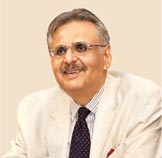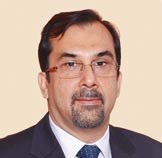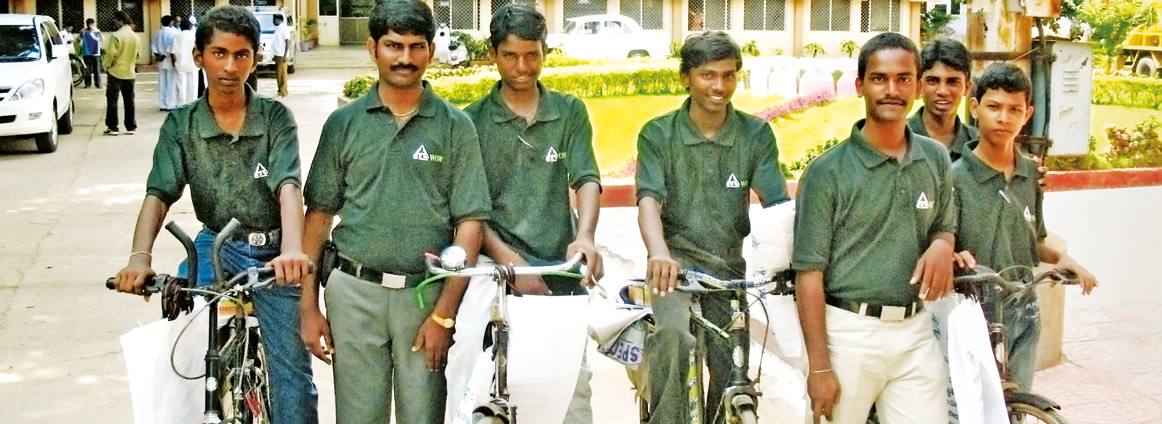 Environment
Environment Economic
Economic Social
Social

 Environment
Environment12 Consecutive years
15 years in a row
for the last 10 years
This Initiative reaches out to over 6.4 million citizens
Over 48% of ITC's Total Energy Requirements met from carbon neutral sources.
22 green buildings

 Economic
EconomicTurnover has grown 11-fold
Profit has grown 39 times
Total Shareholder Returns has grown at a CAGR of 23.6%
Over $50 billion
Over $8 billion

 Social
SocialEmpowering 4 million farmers
Generating over 110 million person-days of employment
Covering nearly 55,000 rural women
Benefitting over 5,25,000 children
Services provided to over 15,00,000 milch animals
Covering nearly 12,500 acres
Training over 46,000 youth
Over 25,000 low-cost sanitary units constructed


It has been our resolve to build an exemplary Indian enterprise that would create enduring value for our country. An organisation that would adopt the credo of putting 'India First' - keeping Country before Corporation and the Institution before the Individual. Over the years, the patriotic sense of 'India First' has grown into a full-blown aspiration to be a National Champion subserving the country's larger priorities. This is not only manifest in the creation of world-class Indian brands, but also in the Triple Bottom Line goals of the Company to nurture larger societal value. The need to sustain global competitiveness in economic value creation, whilst simultaneously creating larger societal value, has led to innovation in business models that seek to synergise the building of economic, ecological and social capital as a unified strategy.
A new paradigm of growth is today called for - an integrated Triple Bottom Line approach that builds competitiveness whilst at the same time ensuring that the environment is nourished and large-scale sustainable livelihoods are created. I call this new paradigm 'Responsible Competitiveness', which to my mind is a pre-requisite to creating a more sustainable future.


'Enterprises of Tomorrow' can bring in transformational change by making societal value creation a conscious strategic decision and not one that banks on corporate conscience alone. ITC has always believed that businesses possess unique strengths to make a larger contribution to society. If the creative and innovative energies that businesses employ to create world-class products and brands are leveraged to deliver social initiatives that serve a larger national objective, it can have a transformative impact on society.
It is this belief that has spurred ITC to craft innovative strategies that orchestrate a symphony of efforts aimed at enriching the environment, creating sustainable livelihoods, empowering local communities and addressing the challenge of climate change.

With increasing population, rapid and unplanned urbanisation and rising consumption levels, waste generation in India has gone up considerably whereas the infastructure required to collect and process the waste remains lagging creating a huge problem of waste disposal. Absence of source segregation has compounded the problem. According to Central Pollution Control Board (CPCB)1, only 27% of the total collected waste is being treated and remaining waste is sent to landfills which creates burden on the environment. Unmanaged waste is not only an environmental but also a health hazard besides being an enormous waste of resources. In an effort to address the waste management issue, a number of regulations such as Solid Waste Management (SWM) Rules, 2016, Plastic Waste Management (PWM) Rules, 2016 have been notified.
Plastics today are an integral part of modern life and have made it possible to reach the benefits of development to the poorest and needy. Its economic and environmental utility in providing insulation, protecting product integrity when used as packaging, etc. have been transformational. Plastic waste though constituting only 7% of total Municipal Solid Waste (MSW), has attracted significant public attention because it is not being managed properly.
Recognising the concerns of plastic waste, the Plastic Waste Management Rules, notified in 2016, adopted the concept of Extended Producer Responsibility (EPR) for plastic packaging which makes Producers, Importers and Brand Owners who introduce products with plastic packaging in the market responsible. ITC believes that the issue of plastic waste management needs to be integrated with the overall MSW management system. Such an effort will avoid duplication of systems not only between MSW and plastic waste management streams, but also between different Producers, Importers and Brand Owners, which, otherwise, will significantly add to the existing challenges of cost-effectiveness of MSW management system. In the Indian context, where the unorganised sector has a significant scale and is estimated to contribute around 2/3rd of the Fast Moving Consumer Goods (FMCG) sector volumes, effectiveness of an EPR approach based on developed country models is unlikely to be effective. The key to success of a comprehensive MSW management system is the ability to achieve collection of segregated waste streams, which is fundamental for value realisation from each waste stream and to prevent littering/landfilling.
Within the boundary of ITC Units, focused efforts are made towards resource conservation by minimising waste generation and improving efficiencies through waste segregation & recycling/reuse. ITC also has direct experience in MSW management through its Well-being Out of Waste (WOW) Programme and Mission Sunehra Kal (MSK) Programmes, which are operating as Corporate Social Responsibility (CSR) initiatives. Our WOW Programme, which covers 6.4 Million households, and MSK solid waste management programme, which covers 61,200 households, focus on source segregation as the key strategy to manage waste.
1Annual review report 2014-15 on Municipal Solid Waste (MSW)

Based on learning's from experience, ITC has crafted the following approach on waste management.
In 2016-17, ITC Units generated 7,11,411 tonnes of waste whereas 7,45,149 tonnes were generated in 2015-16. This 4.5% decrease in total waste generated over last year was primarily due to reduction in fly ash waste in Bhadrachalam Unit of the Paperboards and Specialty Papers Division. This Unit, which accounted for 79% of the total waste generated in ITC during 2016-17, reported a decrease of 5.4% in waste generation as compared to previous year.
In order to continually improve performance in resource conservation, all ITC Units have developed systems to track and monitor the specific waste generation (waste generated per unit of product/service). Out of the total waste generated, combined contribution of Bhadrachalam, Kovai and Tribeni is about 90%. Therefore, significant attention was given to these three Units.
Specific waste generation targets were given to monitor and track the performance of all Units. Performance of these three Units of PSPD in terms of specific waste generation is given in the next column.
All three Units have achieved the targets of specific waste, with Bhadrachalam and Tribeni Units significantly reducing waste generation from previous year. Reduction in waste generation in these Units were primarily due to reduction in ash generation which was attributed to reduction in coal consumption through various energy saving initiatives.
Historically, due to limited options for recycling, most of lime sludge (a waste generated from chemical recovery process in Bhadrachalam Unit) was stored in lagoons within the premises, incorporating adequate precautions to prevent adverse impacts on soil and ground water. In 2014-15, the Unit has formally tied up with cement plants to use lime sludge as an alternate raw material. Continuing with this partnership, the Unit recycled 79,000 tonnes of waste in 2016-17. About 1.01 lakh tonnes of lime sludge is remaining in the lagoons which will be disposed in the next 2 years.

Of the total waste generated by ITC in 2016-17, only 3.7% by weight can be categorised as hazardous waste as per Indian statutes. 95% of the hazardous waste sent out was recycled by authorised external agencies, and the balance 5% was disposed using alternate means in accordance with applicable statutes. All ITC Units have established systems and procedures to verify the relevant authorisations and licenses of agencies used for transporting, recycling or disposing the hazardous wastes, in compliance with applicable regulations and norms. Further, Corporate EHS periodically verifies the compliance in each of the ITC Units. During 2016-17, apart from hazardous wastes transported to authorised external treatment sites by authorised transport agencies as applicable, no hazardous wastes were shipped out of ITC locations.
The table below depicts the final destinations of the total hazardous wastes generated during 2016-17:
During 2016-17, out of the total non-hazardous waste generated in ITC Units, 99.96% waste was reused/recycled. The details of the destinations for the major waste categories, which contributed to more than 85% of the total non-hazardous waste generated in ITC Units in 2016-17, are given below:
ITC strives to maximise resource efficiency encouraging all its Units to take steps to eliminate the creation of waste. Since generation of waste cannot be completely eliminated due to limitations in processes and technology, all ITC Businesses/Units endeavour to work towards 100% recycling of generated waste. 'Segregation at source' along with focused attention on identifying and tracking of all waste streams till their final disposal helped us to recycle 99.8% of the total waste generated within the units, during 2016-17.
To further expand the Company's waste recycling footprint, our Kovai and Bhadrachalam Units of the Paperboards and Specialty Papers Division use postconsumer waste as raw materials. Efforts at ITC Units to recycle the entire waste generated along with utilisation of externally generated waste paper as a source of fibre in the above mentioned Paperboards and Specialty Papers Units, have helped the Company to maintain its solid waste recycling positive status for the 10th consecutive year (refer to the table below).
ITC has also been collaborating with various stakeholders such as municipal corporations, civil society members to work on sustainable management of community waste. Performance of 'Well-being Out of Waste (WOW)' Programme and Waste Management Programme under MSK initiative are detailed in ITC Mission Sunehra Kal for Sustainable & Inclusive Growth section of the Report.
ITC's supply chain boundary covers Third Party Manufacturing (TPM) units catering to Education and Stationery Products Business, two exclusive TPMs of Cigarette Business and ATC Limited, an associate company. Performance of these units is detailed below.
ITC plans to progressively expand the boundary to cover more supply chain partners. Through close monitoring and reporting of waste performance data and sharing experience and good practices, ITC influences its supply chain partners to improve their waste performance.

In context of PWM Rules 2016 and the adopted concept of EPR on plastic packaging, Industry has a critical role to play in providing a holistic solution to MSW management. An effective EPR model needs to be complemented with a national level accounting of plastic packaging introduced into the market by a Producer, Importer or Brand Owner, against which the off-set from appropriate EPR programme should be allowed with phased targets. We will continue to engage with the Government in making these Rules implementable for a holistic solution.
We will continue to focus on plastic waste, and specifically multi-layered laminates, to explore its end-of-life solutions that are environmentally friendly and financially sustainable. While energy recovery from multi-layered laminates has been established as an end-of-life solution, we are also working to develop Recycled Plastic Lumber (RPL) as another viable end-of-life solution for multi-layered laminates.
With learning from our direct experience on MSW management, we strongly believe that the following elements are essential for a comprehensive solution to MSW management:
a) Public-Private Partnership (PPP) Programmes on MSW management should be rolled out across the country, initially in urban centres, that integrates MSW and plastic wastes management. These PPPs must be driven to primarily meet the interests of the unorganised waste picker communities and all incomes generated should be channelised towards betterment of their livelihoods.
b) A significant portion of plastic wastes in India constitute multi-layered laminates and light weight plastics, which represent the visible part of plastic wastes getting littered or ending up in landfills, as low realisation from these categories of plastics do not make it viable for waste pickers to collect and segregate them. Energy recovery from these plastic wastes can be achieved by using them as an alternative fuel (replacing coal/coke) in cement industry. While this use in the cement sector is an established practice, this end-of-life treatment option will become financially viable and sustainable only when these plastic wastes obtain value realisation based on their quality and calorific value. Apart from energy recovery solution, we are also working to develop Recycled Plastic Lumber (RPL) as an alternate end of life treatment solution for multi-layered laminates.
c) Use of wet organic waste for production of bio-gas, with manure as a by-product, also needs further development. By and large, municipal wet organic waste in India remains under-exploited barring some isolated small-scale efforts at composting or gasification. We are convinced that the technology for large-scale gasification of these wastes for conversion to fuel is matured and the business model is viable. Solid residues, post gasification of wet organic wastes also serve as manure which creates one more potential revenue stream, thereby improving financial viability and independence of the integrated model.
d) Land, transportation and other infrastructure support should be provided by Urban Local Bodies for collection, sorting and pre-processing of different waste categories.
e) Behavioural change at the individual waste generator level for waste segregation at source requires sustained engagement and regulatory backing.
While Industry can facilitate setting up of waste management systems through capacity building, knowledge sharing and initial set-up support, the system itself must operate on a business for profit model, with all value created going to the main stakeholders, particularly those involved in collection, handling, sorting and management of waste. In our opinion, financial viability of integrated MSW and plastic wastes management models is what will drive its uptake across the country and determine its scalability.
ITC is calibrating its strategy for tackling the issue of post-consumer waste management in partnership with government, municipal corporations, NGOs, communities and other stakeholders.

